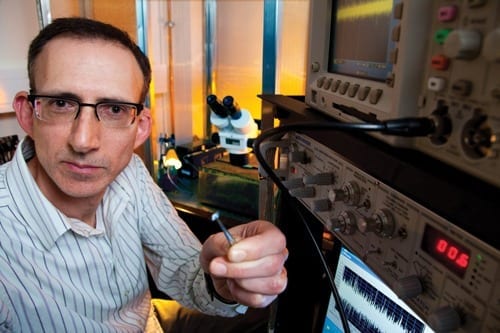
The method is aimed at colorectal and lung cancers, which are difficult to diagnose in their earliest stages.
Using tiny “nanopore” scanners that can detect individual DNA molecules, Professor Amit Meller and colleagues are on the hunt for biological markers in cancer cells that may help clinicians diagnose colorectal and lung cancers at their earliest stages.
Prof. Meller, of the Faculty of Biomedical Engineering at the Technion-Israel Institute of Technology, leads a research group that is a partner in BeyondSeq, an international research consortium looking for new methods of decoding genetic and epigenetic information from medical samples. BeyondSeq, supported by a €6 million grant from Horizon 2020, the European Union’s framework program, was one of only eight consortia chosen out of 450 submitted proposals.
“We are the only lab in the consortium working on early diagnosis of cancer biomarkers, which…will allow doctors to combat the cancers much more effectively and save human lives,” Meller explained. “Currently there are no good ways to diagnose colorectal cancer and lung cancer at early stages. Usually these cancers are diagnosed at later stage (stage 2 or above) in which the patients may already have multiple secondary tumors, hence highly complicating treatment.”
The nanopore technology developed by Meller and colleagues consists of tiny holes—about 100,000 times smaller than the thickness of a sheet of paper—drilled in ultra-thin silicon membranes. The researchers pass a current of electrically charged salt ions through the nanopore that attracts molecules such as DNA, which have their own natural electrical change, toward the pores. The DNA molecules are threaded through the pore and as they slide from one side of the membrane to the other, the pore acts as a scanner. Both optical and electrical signals given off as the molecule passes through the pore are detected providing information on the DNA properties, such as its length and sequence variations.
Meller said his team will be using the nanopores to looking at slight variations in the DNA nucleotides or “letters” that spell out the KRAS gene, which has already been identified as an important biomarker in colorectal and lung cancers. “We can encode the nucleotides variations in the KRAS gene with sets of color-emitting dyes and read the information with our nanopore sensor. We hope that our nanopore technology can be adapted for early detection, where the sensing of these biomarkers is currently extremely challenging and not accessible by conventional methods,” he said.
Nanopores could prove especially useful for early detection because they can scan very small amounts of molecules, uncovering the few cancerous cells or molecular markers of cancer in a large sample of healthy blood or tissue, he added.
The team is also developing a nanopore-based method to detect epigenetic modifications at the single-molecule level. Epigenetic modifications are chemical changes made to a DNA molecule. These chemical changes don’t alter the sequence of DNA letters that spells out a gene, but they can affect how the protein encoded by that gene is expressed inside a cell. (Some people have likened this difference to the markings on a musical score: think of the genetic sequence as the musical notes, while the epigenetic modifications are the instructions that tell a musician whether to play the note softly or loudly, for instance.)
Nanopores offer one way to see whether a piece of DNA has some of these epigenetic instructions attached to it, which could help scientists determine whether any of these instructions correlate to how a disease like cancer develops.
Meller and his colleagues have been developing the possibilities of nanopores for more than 15 years. In a paper published in Scientific Reports earlier this year, they demonstrated that the pores could detect the presence of a single transcription factor, a protein that activates the production of messenger RNA from the DNA. The pore’s scanning capabilities were even powerful enough to distinguish between two separate ways that the transcription factor could bind itself to the DNA, each with its own transcriptional effects.
Read more: RESEARCHERS USE “NANOPORE” SCANNERS TO FIND EARLY SIGNS OF CANCER
The Latest on: Nanopore Scanners
[google_news title=”” keyword=”Nanopore Scanners” num_posts=”10″ blurb_length=”0″ show_thumb=”left”]
via Google News
The Latest on: Nanopore Scanners
- Oxford Nanopore Technologies PLCon April 26, 2024 at 7:52 am
1 Day ONTTF 4.17% DJIA 0.40% S&P Mid Cap 400 0.29% Health Care/Life Sciences 0.40% Stocks: Real-time U.S. stock quotes reflect trades reported through Nasdaq only; comprehensive quotes and volume ...
- Oxford Nanopore Technologieson April 18, 2024 at 6:46 am
Joint development collaboration to bring leading-edge nanopore sequencing into clinical laboratories at Mayo Clinic to increase understanding and improve treatment of cancer and genetic disorders.
- Best Stock Scanners and Screenerson April 7, 2024 at 5:00 pm
That's why it's important to find the best stock scanners. You might be wondering how anyone decides which stocks to buy or sell and how traders find new purchase opportunities. The answer to both ...
- UK airports given more time to get new scanners in place that will lift liquid restrictionson April 3, 2024 at 10:40 pm
The airports include London’s two biggest, Heathrow and Gatwick. The new scanners use computed tomography, commonly known as a CT scan, to produce clearer images. They are being rolled out ...
- Body scanners coming to NYC subway stations as city struggles to get a grip on surging crimeon March 28, 2024 at 12:15 pm
Crime in NYC subway stations has gotten so out of control that Democratic Mayor Eric Adams announced Thursday that body scanners are coming to the city's stations. The scans will be used to detect ...
- Free yourself from clutter with the best document scanners in 2024on March 11, 2024 at 11:44 am
Using one of the best document or photo scanners, it's easy and quick to create digital versions of important papers or photos and keep them stored securely in your computer or the cloud.
- Windows Hello Fingerprint Scanners Were Hacked: Should You Still Use Them?on November 28, 2023 at 1:54 pm
Logging into a Windows laptop with a fingerprint scanner is easy; just place your finger on a scanner, and the operating system lets you in. However, researchers have shown that, while this method ...
- Top 10 Fingerprint Scanners for Windows PCon November 9, 2022 at 8:55 am
Well, we do have Fingerprint Scanners that provide us with an easy solution when it comes to logging into our devices. These scanners are designed specifically to aid our accessibility requirements.
- The Coolest 1990s Film Scanner To Work With Windows 11on September 5, 2022 at 9:40 pm
A profitable sideline for photography shops was providing scans of film, and there were a series of high-end scanners aimed at that market. [Kai Kaufman] shares the experience of making one of ...
- film scanneron July 29, 2022 at 5:00 pm
Film scanners are a useful tool for digitizing slides and negatives, and the Plustek 8100 that [Christian Chapman] had was capable, but limited to small format film only. Rather than pay for a ...
via Bing News










